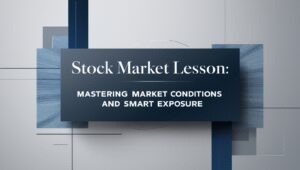A Comprehensive Guide to Trading Psychology
Quiz ( we suggest you listen to the audio and/or read the lesson below before taking the quiz )
In the fast-paced world of stock market trading and investing, technical knowledge alone isn’t enough to ensure success. The real edge often comes from mastering the mental aspects of trading. This comprehensive guide will explore how understanding and leveraging mental strategies can enhance your decision-making, improve risk management, and lead to more successful trading outcomes.
1. The Power of Mental Representations in Trading
At the core of trading psychology are mental representations and meta-modalities – the ways we perceive and process information related to our trades. These aren’t just abstract concepts; they’re the building blocks of how we interpret market information and act on it.
Understanding Meta-Modalities
Meta-modalities are the qualities we associate with our sensory experiences. In trading, this could be:
- How you visualize a potential trade (clear and vivid vs. fuzzy and indistinct)
- The internal dialogue you have when considering a trade (confident and assertive vs. hesitant and doubtful)
Practical Application
To harness the power of mental representations:
- Reflect on a recent trading decision. Identify the meta-modalities that influenced your choice.
- Practice shifting negative or unclear perceptions to more positive, clear ones.
- Develop detailed, vivid visualizations of your trading strategies and goals.
Remember, the aim isn’t to ignore risks or become overly optimistic, but to develop a balanced, clear mental representation that supports informed decision-making.
2. Balancing Motivation Strategies: The Carrot and the Stick
Understanding what drives your actions in the market can profoundly impact your trading outcomes. We’ll explore two primary types of motivation: “toward” motivation (the carrot) and “away from” motivation (the stick).
“Toward” Motivation
- Focus on potential profits and positive outcomes
- Can drive you to seek opportunities and stay engaged
- May lead to overconfidence or excessive risk-taking if not balanced
“Away From” Motivation
- Emphasis on avoiding losses and negative outcomes
- Can promote conservative, risk-aware decisions
- Might lead to missed opportunities if taken to an extreme
Finding Your Balance
The key is to recognize your dominant motivation strategy and learn to balance it. Successful traders often combine both “toward” and “away from” motivations, using the desire for profit to drive action while tempering it with a healthy respect for risk.
Action Step: Analyze your recent trades. Were they primarily driven by potential gains or fear of losses? Experiment with consciously balancing these motivations in your next trades.
3. Unveiling Your Trading Meta Programs
Meta Programs are deeply ingrained thought patterns that often influence your behavior unconsciously. In trading, recognizing these patterns can help you make more informed decisions.
Key Meta Programs in Trading
- Black-and-White Thinking: Seeing situations as all-or-nothing without recognizing nuances.
- Risk Orientation: Your natural tendency to either seek or avoid risks.
- Pessimism vs. Optimism: Whether you focus more on potential losses or gains.
- Detail-Oriented vs. Big Picture: Preference for focusing on specifics or broader trends.
- Internal vs. External Frame of Reference: Relying on your judgment or seeking external validation.
Leveraging Your Meta Programs
Identifying your dominant Meta Programs isn’t about pigeonholing yourself. It’s about recognizing these patterns so you can adapt and adjust your strategies accordingly.
Self-Reflection Exercise:
- Do you tend to see trades in black and white, or recognize complexities?
- Are you naturally inclined to take risks, or do you prefer playing it safe?
- Do you focus more on potential gains or losses when evaluating a trade?
Once you’ve identified your dominant Meta Programs, develop strategies to balance out any extremes. For instance, if you’re heavily detail-oriented, set aside time to look at broader market trends.
4. The Art of Managing Your Mental State
Your mental state – your mood, energy level, focus, and emotional balance – directly impacts your trading performance. When you’re in an optimal state, you can think clearly, react appropriately to market changes, and stick to your trading plan.
How Mental States Affect Trading
- Stress: Can lead to impulsive trades or holding onto losing positions out of fear.
- Fatigue: Slows reaction times and impairs processing of complex information.
- Overconfidence: May result in excessive risk-taking.
- Anxiety: Can cause hesitation on good opportunities or premature exits from profitable trades.
- Excitement: While positive, it can lead to impulsive trading and deviation from your plan.
- Calm Focus: Often considered the ideal state for clear analysis and rational decision-making.
Techniques for Optimal Mental State
- Mindfulness and Meditation: Increases awareness of your mental state and improves emotion regulation.
- Deep Breathing: Calms your nervous system and reduces stress in the moment.
- Visualization: Mentally rehearsing successful trades prepares your mind for peak performance.
- Physical Exercise: Reduces overall stress and improves cognitive function.
- Adequate Sleep: Crucial for maintaining good decision-making abilities.
- Pre-Trading Routine: Helps consistently enter an optimal mental state for trading.
Daily Practice: Before making a trade, assess your mental state. If you’re not in an optimal state, use one of the techniques above to recenter yourself.
5. The Synergy of Strategy and State
Successful trading isn’t just about having the right strategy or being in the right mental state – it’s about effectively combining both.
Integrating Strategy and State
Think of your trading strategy as a roadmap and your mental state as the vehicle navigating this map. The best strategy won’t be effective if your mental state is off-kilter, and the calmest mind can’t compensate for a lack of strategic planning.
Developing a Holistic Trading Approach
- Pre-Trading Routine: Combine strategic preparation with mental state management.
- Regular Strategy Review: Analyze past trades and refine your approach.
- Ongoing Mental Training: Make psychological preparation as important as market analysis.
- Journaling: Track your trades, mental states, and emotions to identify patterns.
- Simulated Trading: Practice executing your strategy under different mental states.
- Feedback Loop: Regularly assess how well you’re sticking to your strategy and managing your mental state.
Implementation Challenge: Create a pre-trading routine that includes both strategy review and mental state preparation. Use it consistently for two weeks, journaling your experiences and outcomes.
Conclusion: Your Journey to Trading Mastery
Mastering the mental aspects of trading is an ongoing journey. The concepts we’ve explored – understanding meta-modalities, balancing motivation strategies, recognizing Meta Programs, managing mental states, and combining strategy with state – are powerful tools in your trading arsenal.
Remember, successful trading isn’t just about technical knowledge or the perfect strategy. It’s about developing a holistic approach that integrates your analytical skills with a deep understanding of your own psychology.
View each trade as an opportunity for self-discovery and growth. Pay attention to your thought processes, emotional reactions, and how they impact your decisions. Over time, this self-awareness will become one of your greatest assets in the market.
There’s no one-size-fits-all approach to trading psychology. Experiment with different techniques, be honest with yourself about what’s working, and don’t be afraid to make adjustments.
Finally, be patient and persistent. Developing a strong mental framework for trading takes time. Treat your development as a trader with the same level of dedication and strategic thinking that you apply to your trades.
Start implementing these concepts immediately, beginning with small, manageable changes. Remember, the goal is progress, not perfection. Every step you take towards better understanding and managing your trading psychology is a step towards becoming a more successful and fulfilled trader.
Happy trading, and may your newfound psychological insights lead you to greater success in the markets!





